Water supply copper pipes: assortment marking, scope, advantages
Exceptional reliability, anti-corrosion qualities and resistance to water hammer make copper water pipes the leader in pipe fittings. The limited use of rolled copper is a consequence of the high cost of products.
Nevertheless, capital investments in the water supply system are completely justified and allow the consumer not to think about the reconstruction of the utility network for decades. In addition to durability, in this article we will analyze other advantages of a copper pipeline and note the disadvantages.
We will also consider the composition, main characteristics, marking features of copper pipes and features of their use in various fields.
The content of the article:
Composition and characteristics of copper pipes
Copper water supply is a fairly exclusive option for arranging a communication system. Despite the mass of absolute advantages, the use of copper is being resorted to less and less. The main reason is the emergence of affordable alternative materials (plastic and metal-plastic fittings).
Metal alloy M1 is characterized by the highest copper content. The purity of the alloy ensures high ductility, electrical and thermal conductivity, as well as corrosion resistance.The material is flexible to different processing technologies.
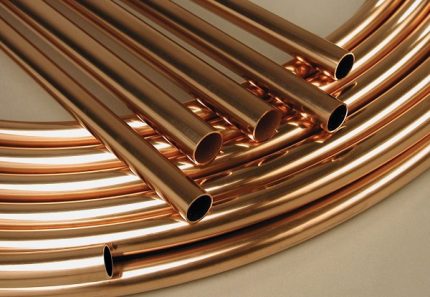
Mass fraction of alloy M1 components:
- copper and silver – 99.9;
- oxygen – 50;
- iron, lead – 5 each;
- sulfur, zinc – 4 each;
- tin, antimony, arsenic and nickel – 2 each;
- bismuth – 1.
In the M2 composition, the mass fraction of copper/silver is reduced to 99.7, the nickel and oxygen content is increased to 200 and 70, respectively. The proportion of tin and iron has been increased to 50. The primary copper alloy has similar characteristics to the M1 metal alloy.
Technical copper (M3) is the result of secondary smelting or fire refining. The material is distinguished by a significant mass fraction of nickel (200), tin, lead and arsenic (80 each). Copper content – 99.5. M3 alloy copper pipes have good strength and affordable cost.
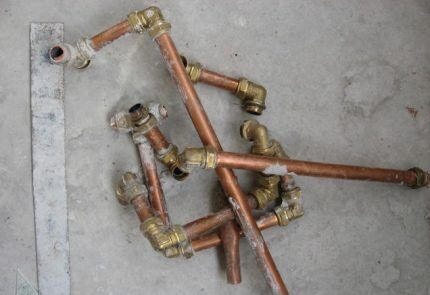
Characteristics of copper pipes:
- operating temperature range – from -200 °C to +300 °C;
- permissible pressure - 100-200 atmospheres (for a number of brands the limit value reaches 450 atmospheres);
- relative elongation at break – 10-40%;
- diameter of water fittings – 3-350 mm, wall thickness – 0.8-10 mm;
- design service life is more than 70 years.
The critical operating temperature of a copper water supply depends on the method of connecting the elements and the type of solder used. In more detail about the technology of installing copper pipelines, we talked here.
The actual service life significantly exceeds the period declared by the manufacturer. The oldest copper communications in Europe have been in use for two centuries without replacement.
Strengths and weaknesses of copper plumbing
Copper pipes are similar to their closest competitors (steel communications) in terms of strength and temperature characteristics. However, copper is more preferable due to its unique properties.
The main advantages of copper pipes
Copper pipes have their positive and negative aspects. First, let's look at the advantages of copper piping.
Corrosion resistance and ductility
Perhaps the main argument in favor of copper plumbing is its immunity to rust. This property explains the duration of uninterrupted operation of utility networks and minimizes the negative impact on plumbing fixtures.
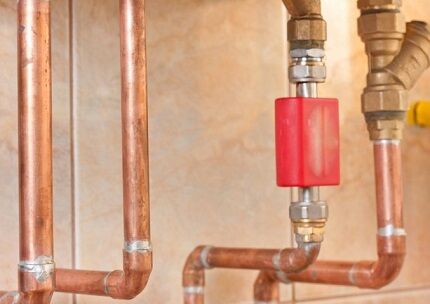
Plasticity - this quality explains a number of significant operational advantages of a copper pipeline:
- flexibility of the material in processing - pipes can be bent to create complex trunk networks using hand tools;
- retention of a given shape - soft polymer products cannot boast of this property;
- possibility of application connection fittings;
- probability of deformation without mechanical destruction;
- temperature jumps do not cause changes in linear parameters;
- withstands freeze/thaw cycles while maintaining integrity.
Another point is increased resistance to water hammer. The indicator of destructive pressure allows you not to fear for the integrity of the system during “jumps” in water pressure.
Surface smoothness and bactericidal properties
An archival argument in favor of copper plumbing. The high homogeneity of the material ensures a perfectly even coating, which reduces the molecular bonds of the metal, which means the formation of salts and oxides is reduced.

Copper alloy has antibacterial properties - as water circulates through the pipes, it is partially disinfected. An additional plus is that colonies of microorganisms do not multiply on the walls.
Resistance to chemicals and UV rays
Copper is not destroyed when interacting with saline solutions, formalion and dilute non-oxidizing acids. When in contact with chlorine, it does not form oxides hazardous to humans.
Copper does not lose its characteristics under the influence of UV radiation, which cannot be said about communications made of thermoplastic polymers.

Along with good strength indicators, copper alloy pipes are somewhat lighter in weight than their steel counterparts. This makes them easier to transport and install. The indisputable advantage of a copper pipeline is the possibility of repeated use.
Disadvantages of a copper pipeline
The copper pipeline also has its negative aspects. Let's look at them in more detail.
The disadvantages of copper water pipes include:
- High price. When compared with the cost of analogues, copper products lose out. Setting up a network made of “yellow” metal will cost several times more than installing a plastic or steel main line.
- Labor intensity of installation. All docking technologies copper fittings (assembly with fittings or soldering) are quite complex processes that require work skills.
- Acid intolerance. Copper pipes cannot be used to transport acidic media with a pH level of more than 9. Water with this indicator is not suitable for drinking.
- Thermal conductivity. The parameter is 1.7 times higher than that of aluminum products and almost six times higher than the thermal conductivity of steel. When transporting a hot medium, the pipe heats up - heat losses increase, and there is a risk of burns.In cold water supply systems, condensation forms on the pipeline.
The problem can be solved by using a coating made of polyvinyl chloride or polyethylene. The outer sleeve prevents condensation, “cools” the surface, maintains the temperature of the transported medium and reduces noise.
Copper pipes with external thermal insulation are used only in cases where it is necessary to reduce the impact of the external environment on the water supplied by the system. They are also needed to prevent ice jams that can disrupt the functionality of the water supply system.
The copper pipes themselves are not threatened by the processes of freezing and subsequent thawing. The plasticity of copper allows it to maintain tightness even if the pipeline had to be slightly deformed under the influence of an ice plug.
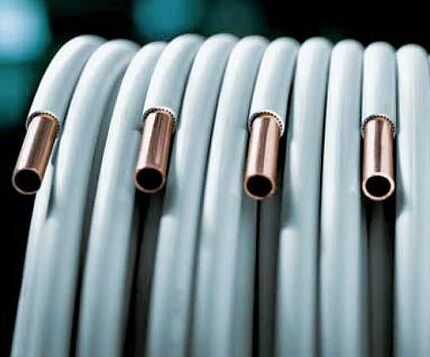
Additional disadvantages of using rolled copper are electrical conductivity, as well as incompatibility with aluminum and steel elements of the water supply system. To prevent the risk of electric shock, care should be taken to properly ground the equipment during installation.
A significant disadvantage of copper pipes is the occurrence of electrochemical corrosion, which appears as a result of contact of copper with other materials:
Variety of copper pipes
The choice of material for arranging a copper water supply system should be based on an assessment of a number of parameters: manufacturing method, level of lamellarity and strength, as well as overall dimensions. The ability to decipher product range markings will help you navigate the variety of pipe fittings.
Classification #1 - by production method
The production of copper pipes in accordance with GOST is carried out using one of the technologies: cold rolling, pressing followed by welding. Production tactics affect the performance of the finished product.
How are pipes made by rolling?
The technology involves the deformation of a metal workpiece as it passes between the rotating shafts of a pipe rolling machine.
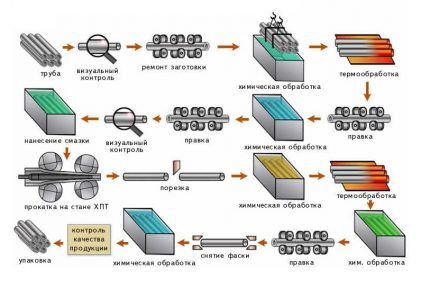
The rolling takes place step by step - with each feed the sleeve rotates 90°, ensuring uniform processing and the absence of longitudinal marks on the pipe.
Advantages of “rolled” fittings:
- Seamless design ensures high strength;
- accuracy of parameters along the entire length of the product.
The cold deformation method is used to create water and heating copper pipes that experience significant pressure from the inside during service.
At the final processing stage, pipe fittings may be subjected to thermal treatment. This is done in order to return the copper to its elasticity.
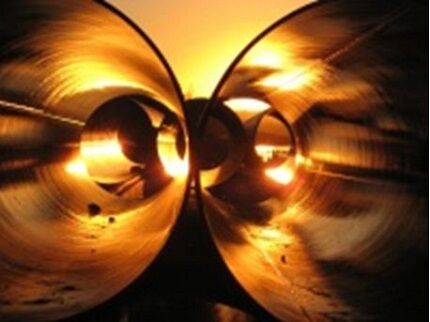
Pipes are:
- unannealed;
- annealed.
Unannealed ones have the following characteristics: “rigidity” in bending, resistance to external damage and water hammer (limit – 450 MPa). Suitable for assembling a simple configuration of water pipes.
Annealed ones have the following parameters: high ductility (when stretched along the length by 1.5 times, they retain integrity), increased cost.
Manufacturing by pressing method
The pipes are made from copper sheets - the metal sheet blank is fed to the press forming rollers of the machine. After shaping, the joining seam is welded.
The final stage is the passage of the pipe through calibrating rollers to level the profile and eliminate longitudinal deformation.
Classification #2 - by degree of hardness
Mechanical properties and scope of application are determined by the type of pipe. Copper fittings are usually classified into three categories, characterizing the ductility and strength of the product.
Hard rolled products
This niche is represented by unannealed specimens. Possible markings of solid pipes: T, N, z6, F30. The material is optimal for creating central channels of water supply networks where water is supplied under high pressure.
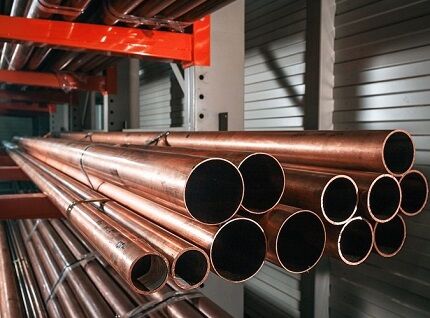
Semi-solid pipe type
Coding options for semi-rigid pipes: P, NN or z. They are distinguished by balanced characteristics of elasticity and strength. The relative elongation of a pipe with an outer diameter of 3 mm and a wall thickness of 0.8 mm is 10%. The same figure for soft rolled products of the same standard size is 38%.
Parts made from semi-solid "meter" can withstand expansion when the outer diameter expands by 15%. Changing the geometry of the pipeline is carried out using a pipe bender.
Features of soft pipes
Marking of soft pipes – M, W, F22 or r. The products are flexible and do not break when dispensing the outer diameter up to 25%. Pipe products are supplied in coils.
The main scope of application is the installation of utility networks with radial distribution of connections to devices. You can give the desired shape to a small-diameter pipeline yourself without special equipment.
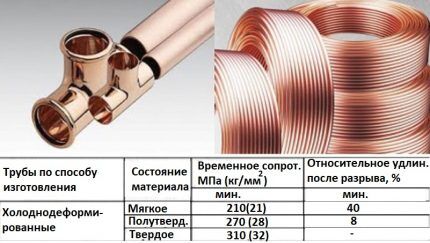
Classification #3 - by overall dimensions
The main parameters of pipe dimensions are internal, external diameter and wall thickness. The malleability of copper to processing allows the production of pipe lines of various shapes and dimensions. GOST 617-2006 the assortment of copper fittings included about 130 items with original cross-sectional indicators, of which about 70 are rolled products.
Unlike the previously valid document (GOST 617-19) in the new resolution the dimension is displayed in millimeters rather than inches. The main dimensions are indicated in fractional terms. The numerator identifies the outer diameter, the denominator identifies the wall thickness. Previously, only the outer size (3/8 inch) was indicated.
An example of deciphering the dimension of a pipe 15/1:
- diameter on the outer surface – 15 mm;
- internal section – 14 mm;
- wall thickness – 1 mm.
The length of domestically produced pipe products depends on the diameter. With a cross-sectional size within 18 mm - coils of 10 m in length or measured sections of 1-6 m (assortment step - 0.5 m). Larger specimens are produced in sections of 1.5-6 m.
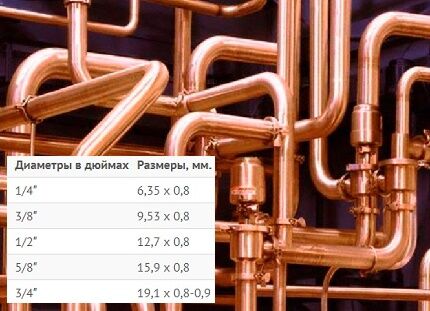
Much less often, rectangular pipes are used in water supply. The products are manufactured mainly using pressing technology, dimensions: diameter - 30-280 mm, wall thickness - 5-30 mm.
Regulatory requirements according to GOST
External parameters, mechanical characteristics, alloy composition, product range and marking designations are regulated by two main provisions: GOST 617-2006 (General purpose copper pipes) and GOST 11383-75. European-made products meet according to EN-1057 standard from 2006.
Set of requirements:
- The internal and external surface of the pipe should not be contaminated to prevent inspection of the products. The presence of delaminations, rust, cracks and cavities on the pipe “sleeve” is unacceptable.
- A dent up to 0.25 mm deep is acceptable. The quantity limit is no more than two per linear meter and no more than 10% of defective products per delivery batch.
- No burrs at the ends of the pipes. The normalized cutting bevel for specimens with a diameter of up to 20 mm is 2 mm, for products with a cross-section of 20-170 mm - 3-5 mm, respectively, for pipe fittings with a diameter of 170 mm or more, a bevel of 7 mm is acceptable.
- For coils and soft pipes, ovality is not limited.
Each coil or batch of pipe sections must be accompanied by a packing slip and information label.
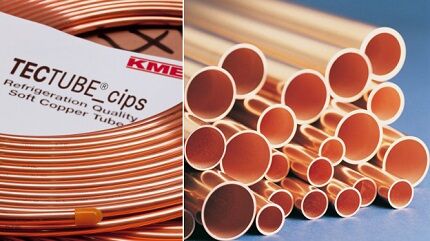
Explanation of designations for pipe products
Basic characteristics are grouped in pipe markings.
Conditional indicators are prescribed according to a clearly defined scheme:
- Manufacturing technology: D – cold-deformed, G – pressing.
- Cross-section geometry: KR – round shape.
- Production accuracy indicator: N – within normal limits, P – increased accuracy in relation to diameter/wall thickness, I – high accuracy in diameter, K – maximum accuracy in relation to the wall.
- Type of material by plasticity. In addition to the indicated abbreviations M/P/T (soft/semi-hard/hard pipe), the following product markings are used: L – soft with high elasticity, F – semi-hard with increased strength, H – hard with high strength.
- Dimensions – value of outer diameter/wall thickness.
- Length: ND and MD - unmeasured and measured pipelines, respectively, KD - rolled products multiple to the measured ones, BT - supplied in coils.
- Metal grade, which determines the composition of the alloy.
- Special conditions: B – high accuracy in length, O – accuracy in curvature, P – regulated tensile standard, H – confirmed Vickers hardness, BU and BS – ordered and spiral winding of the coil, respectively.
Missing data is replaced by an "X".
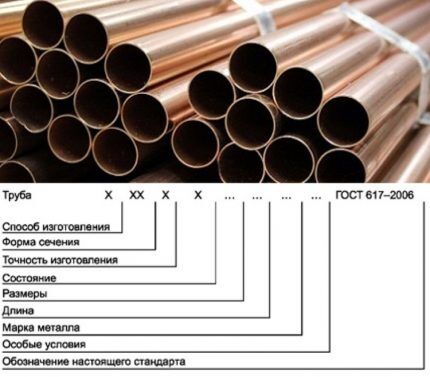
Scope of application and limitations of use
Rolled copper pipes are used in various communication systems for domestic and industrial purposes.
Plumbing and heating network
Traditionally used in arranging water supplies for various purposes. The characteristics of copper and an extensive range of rolled pipes make it possible to equip pipelines of different capacities and meters.
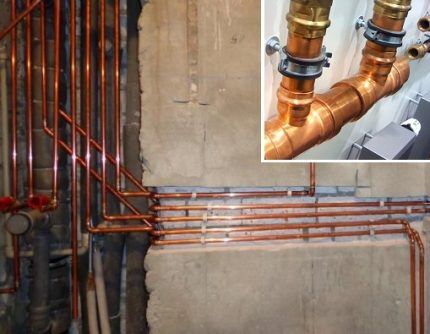
A double effect is achieved in the heating network. On the one hand, durability of operation due to corrosion resistance, on the other, protection of the system from unregulated changes in coolant temperature. But these effects are achieved only with proper pipeline assembly.
We wrote in more detail about the types of copper pipes for heating and the features of their installation in next article.
The use of a copper pipeline with an insulating sheath is justified in underfloor heating systems.
Gas pipeline and fuel system
The convenience of rolled copper lies in the tightness of the line. There is no oxidation or galvanic corrosion during gas transportation. The reliability of pressed connections and solders increases the safety of the gas pipeline in areas with seismic activity.
Due to its neutrality, copper fittings are used in networks for pumping fuel oil - there is no risk of ignition or the formation of a static charge.
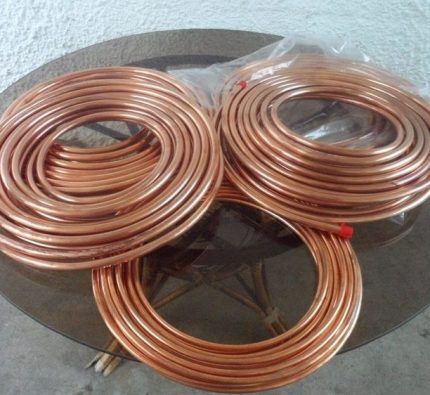
Nuances and limitations of use:
- The limiting speed of liquid transportation in a water supply system is 2 m/s. Compliance with the recommendation will extend the service of the “plastic” highway.
- Copper is a soft metal and constant contact with an environment filled with solid particles can lead to “washing out” of the walls. To prevent the formation of erosion, it is advisable to ensure preliminary cleaning of the water from foreign matter. It is enough to install a coarse (mechanical) filter.
- Under favorable conditions, an oxide film appears on the internal walls of the copper main - the coating does not impair the quality of water and protects the metal from wear. Requirements for the formation of patina: acidity of the water stream pH – 6-9, hardness – 1.42-3.42 mg/l. With other parameters, cyclic destruction and restoration of the film occurs due to the consumption of metal.
- Lead solder should not be used for installation of drinking water supply - the metal and its compounds are toxic. The substance can accumulate in the body, causing a gradual detrimental effect on various organs.
It is permissible to connect copper communications with a pipeline made of brass and plastic. When combining copper pipes with steel and aluminum elements, you must adhere to the joining sequence.
In addition to soldering, compression and crimping technologies are used to connect copper pipes:
Copper pipes of large diameters are connected mainly with flanges and bolts screwed into them; soldering into the socket is allowed; compression methods are used extremely rarely.
Conclusions and useful video on the topic
Video reviews will complement the information presented. Competitive advantages and negative characteristics of a copper pipeline, features of installation work:
Technology for connecting pipes using fittings and soldering:
The advantages of copper water supply are undeniable. A wide range of rolled pipes allows you to choose the optimal material to solve a specific problem.Subject to compliance with installation techniques and operational recommendations, uninterrupted water supply service is guaranteed for over 50 years.
Have you thought about buying copper pipes for installing a plumbing system, but still doubt the feasibility of such a decision? Ask your questions under our article - our experts and owners of copper plumbing will help dispel your doubts.
If you are the owner of such a pipeline, write your opinion about its use, add real photos and recommendations for selection and installation.




Copper pipes for home plumbing are the most ideal option due to their durability, reliability and antibacterial properties (neither mold nor bacteria multiply). But, unfortunately, this is a very expensive option - not everyone can decide to do this; they mostly install plastic ones. And for hot water, it is better to install copper pipes with a heat-insulating coating so that the heat does not escape into the air. Their installation is labor-intensive if you solder, but if you did it once, it will definitely last for half a century. Thing!
The most reliable engineering networks are only welded and made of stainless steel. So, lovers of plastic and copper, don’t talk nonsense. One example is the use of stainless steel in the collapsed Twin Towers in the USA, built to last!
In general, copper has been worth nothing for centuries. Plastic is not the topic here, and stainless steel is even more expensive than copper... and where can you get it? But the properties are almost the same.
Stainless steel pipes are not bad and are quite competitive with copper ones, both in price and quality. But still, I will choose copper - it is much simpler and more convenient to install, is resistant to corrosion, and is generally more reliable.